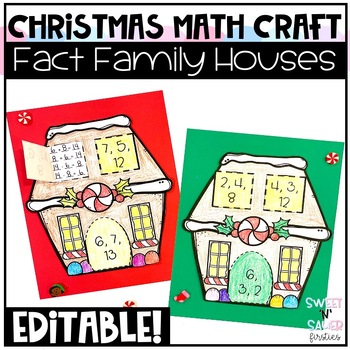Editable Gingerbread Fact Family Christmas Math Craft
- Zip
What educators are saying
Also included in
- Are you looking for fun, engaging, and low prep activities for your students to celebrate Christmas? These are exactly the fun hands on activities for your students to celebrate the holiday AND have a blast doing it! This bundle is FULL of fun and covers a wide range of different literacy and math sPrice $10.00Original Price $14.49Save $4.49
- Are you looking for an engaging way for students to review and practice important math skills? These adorable math crafts gets students creating riddles, bugs, and partitioning donuts while practicing important skills! Not only do these resources give you a quick formative assessment but they are alPrice $15.00Original Price $23.50Save $8.50
Description
Looking for a fun and engaging way for your students to practice fact families? These are the perfect Christmas craft to hang in the hallway or on the bulletin board. These differentiated gingerbread houses are available for addition/subtraction within 20 and multiplication/division!
Learn more about what's included in this adorable activity in the preview. Want to more easy and fun ideas for the month of December? Check out this post HERE!
Grab The Complete MEGA Bundle HERE and save 25%
THIS RESOURCE IS INCLUDED FREE IN THE MEGA BUNDLE!
INCLUDED IN RESOURCE:
- Blank Template
- Addition/Subtraction Houses
- Multiplication/Division Houses
- Editable Version
OTHER CHRISTMAS RESOURCES TO LOVE:
- Christmas Mini Eraser Math and Number Practice
- Holidays Around the World
- Elf Writing and Craft
- Christmas Addition and Subtraction Math Games
- Holiday Pop Up Cards
- Christmas Addition and Subtraction Task Cards with QR Codes
- Christmas CVC Sorting Activity
Click here to try a FREEBIE!
QUESTIONS OR CONCERNS
Email me at lindsaynsauer@gmail.com if you have any questions or concerns about this product. If you are not sure that this product will work for you, please check out one of the freebies. Keep in mind that the preview shows you what the game is going to look like.
Click the Green ★ to follow my store and get notifications when new resources arrive including freebies! New products are always 50% off for the first 24 hours they are posted!
I'd Love to Connect!
CUSTOMER TIPS
How to get TPT credit on future purchases:
Please go to the MY PURCHASES page. Under each purchase, you will see a PROVIDE FEEDBACK button. Click on it, leave feedback, and then you will receive credits for your purchase that you can use on future items (AS IN FREE MONEY to use on TPT)! I do read all the feedback! I can't respond to all of them, but I do value your feedback!
Thank you!
Lindsay Sauer ❤️







